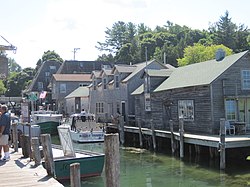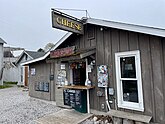
Leland is an unincorporated community and census-designated place (CDP) in the U.S. state of Michigan. It is located in Leelanau County, part of the northwestern Lower Peninsula of the state. As of the 2020 census it had a population of 410. From 1883 to 2004, Leland was the county seat of Leelanau County, which has since moved to Suttons Bay Township.

The Leland River is a short river in the U.S. state of Michigan. Located in the unincorporated community of Leland, the river is 0.9 miles (1.4 km) long and connects Lake Leelanau with Lake Michigan, winding past historic Fishtown, a dam and two restaurants. The dam was built in 1854 and it raised the water level in the river and in Lake Leelanau as much as 12 feet (3.7 m). As the dam prevents boat traffic, launches are provided on both sides.
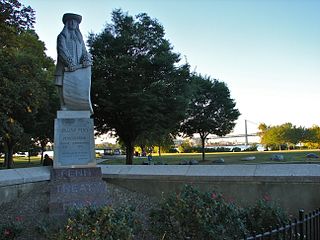
Fishtown is a neighborhood in the River Wards section of Philadelphia, Pennsylvania, United States. Located northeast of Center City Philadelphia, its borders are somewhat disputed today due to many factors, but are roughly defined by the triangle created by the Delaware River, Frankford Avenue, and York Street. Some newer residents expand the area to Lehigh Avenue, while some older residents shrink the area to Norris Street. It is served by the Market–Frankford Line rapid transit subway/elevated line of the SEPTA system. Fishtown is a largely working class Irish Catholic neighborhood, but has recently seen a large influx of young urban professionals and gentrification.

Kensington, colloquially known locally as Kenzo, is a neighborhood in Philadelphia that belongs to or divides Lower Northeast and North Philadelphia. As with all neighborhoods in the city, the lack of any official designation means the boundaries of the area vary between sources over time and are disputed among locals. Kensington, as most long-term residents view it, refers generally to the area consisting of Kensington, East, or Lower Kensington, West Kensington, and Harrowgate. The adjacent Fairhill and Norris Square neighborhoods are more separate but may be included in Kensington; Fishtown and South (Olde) Kensington were historically included. The most conservative boundaries of the neighborhood, shown in the map below, are Front Street and 5th Street to the west, the Amtrak train tracks to the North, Trenton Avenue, the Trenton Avenue train tracks, and Frankford Avenue to the east, and Cecil B. Moore Avenue to the south.

The Kinnickinnic River is one of three primary rivers that flows into the harbor of Milwaukee, Wisconsin, at Lake Michigan, along with the Menomonee River and Milwaukee River. It is locally called the "KK River".

The following is a list of Registered Historic Places in Keweenaw County, Michigan.
This National Park Service list is complete through NPS recent listings posted July 28, 2023.
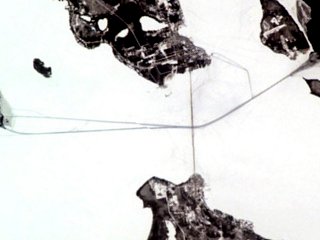
St. Helena Island is an uninhabited 240 acres (97 ha) island in the Lake Michigan approach to the Straits of Mackinac. The island is located offshore from Gros Cap, Michigan, 10 miles (16 km) west of Mackinac Island in Mackinac County in the U.S. state of Michigan.
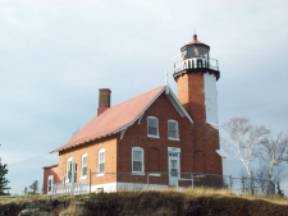
Eagle Harbor Light is an operational lighthouse at Eagle Harbor, in Keweenaw County in the state of Michigan. It sits on the rocky entrance to Eagle Harbor and is one of several light stations that guide mariners on Lake Superior across the northern edge of the Keweenaw Peninsula. The original lighthouse, built in 1851, was replaced in 1871 by the present red brick structure, which is a Michigan State Historic Site and listed on the National Register of Historic Places.

The Harbor Beach Lighthouse is a "sparkplug lighthouse" located at the end of the north breakwall entrance to the harbor of refuge on Lake Huron. The breakwall and light were created by the United States Army Corps of Engineers to protect the harbor of Harbor Beach, Michigan, which is the largest man-made freshwater harbor in the world. Harbor Beach is located on the eastern edge of the Thumb of Huron County, in the state of Michigan.
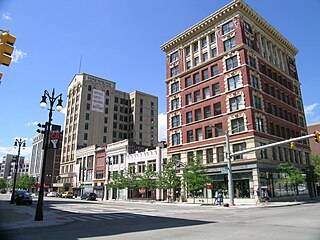
The Broadway Avenue Historic District is a historic district located on a single city block along Broadway Avenue between Gratiot and East Grand River in downtown Detroit, Michigan. It was listed on the National Register of Historic Places in 2004. The Broadway Avenue Historic District joins the Randolph Street Commercial Buildings Historic District, a rare surviving commercial area which dates from the 1840s.

The Edisen Fishery is a fishery located in Rock Harbor in the Isle Royale National Park in Michigan. It was designated a Michigan State Historic Site in 1976 and listed on the National Register of Historic Places in 1977.
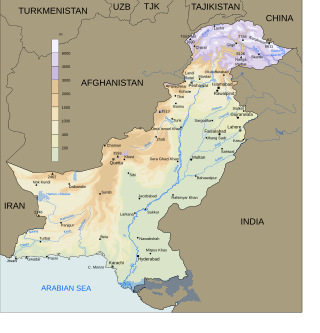
Fishery and fishing industry plays a significant part in the national economy of Pakistan. With a coastline of about 1,120 km, Pakistan has enough fishery resources that remain to be developed. Most of the population of the coastal areas of Sindh and Balochistan depends on fisheries for livelihood. It is also a major source of export earning.

The Johns Hotel (20IR64) is a complex of buildings, of which but two remain, located near Washington Harbor, on Barnum Island, Isle Royale National Park, Michigan. It was listed on the National Register of Historic Places in 1997.
Punta Gorda Fish Co. was a fishing company established in the late 19th century in Punta Gorda, Florida. At least ten of the fish shacks and icehouses built by the company have been listed on the National Register of Historic Places.
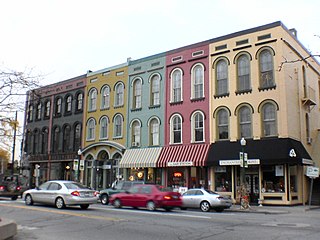
The Ypsilanti Historic District is a historic district located along several blocks on each side of the Huron River in the center of Ypsilanti, Michigan. The original portion of the district was designated a Michigan State Historic Site in 1973 and listed on the National Register of Historic Places in 1978; additions to the district were nationally listed in 1989.
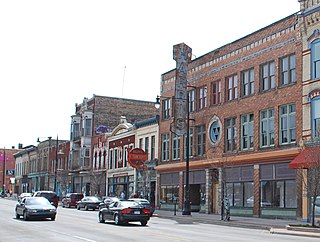
Heartside is a neighborhood located near downtown Grand Rapids, Michigan. Heartside district is a developing area in the city known for its art. It has restaurants, a park with a playground and splash-pad, and a recently opened farmer's market. However, it also has experienced much urban decay, features numerous abandoned buildings, and contains a large presence of homelessness.

The Jim Scott Fishhouse is a historic building in Grand Marais, Minnesota, United States, built in 1907 by a family-owned commercial fishing outfit. During the fishing season it served as a place to dress and pack fish, while over the winter it was used for the storage and repair of fishing gear. The Jim Scott Fishhouse was listed on the National Register of Historic Places in 1986 for having local significance in the theme of commerce. It was nominated for being a representative of the important commercial fishing industry on the upper North Shore of Lake Superior.

The Minong Traditional Cultural Property is a Traditional Cultural Property (TCP), which was listed on the National Register of Historic Places in 2019. Minong is the Ojibwe name for Isle Royale, and the TCP designation recognizes the lasting relationship the Grand Portage Band of Lake Superior Chippewa has with the island. The TCP covers the island itself, the greater archipelago, and the traditional fishing waters surrounding the islands.
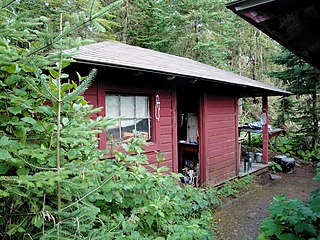
The Tobin Harbor Historic District is a small resort community, consisting of 12 private camps and a fishery, scattered among several islands at the northeast end of Isle Royale near Rock Harbor. It was listed on the National Register of Historic Places in 2019.

The Sault Ste. Marie Historic Commercial District is a primarily commercial historic district located in Sault Ste. Marie, Michigan. It was listed on the National Register of Historic Places in 2020. The district includes the Old Federal Building, Chippewa County Courthouse, Central Methodist Episcopal Church, the Adams Building, and the Gowan Block, all of which are listed separately on the National Register.

